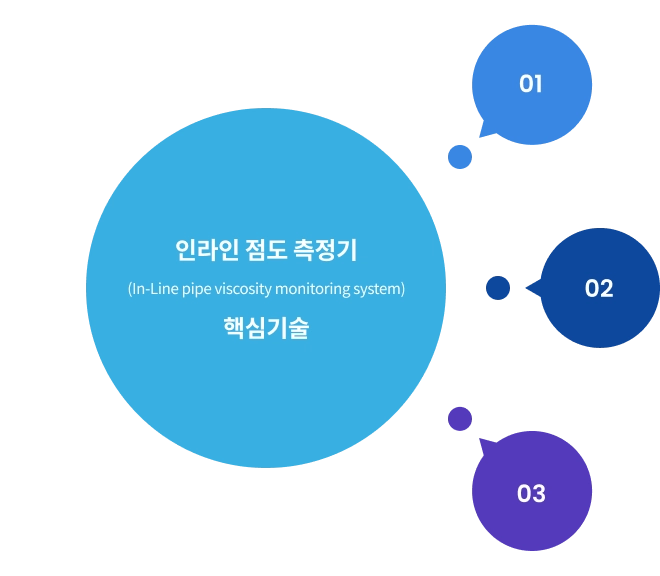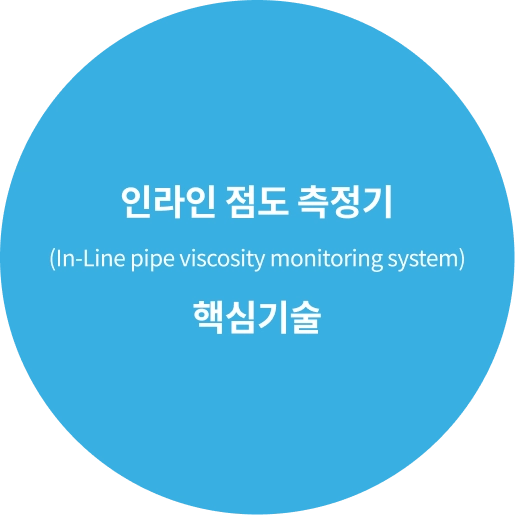In-Line Pipe Viscosity Monitoring System

Definition of In-Line pipe viscosity monitoring system
In-Line pipe viscosity monitoring system
The In-Line Pipe Viscosity Monitoring System (In-Line Viscosity Meter) is a crucial piece of equipment used in battery manufacturing processes to monitor the viscosity of fluids in real-time. Viscosity is a physical property that represents the resistance to flow of a fluid, and it is a key factor in determining the quality and performance of the fluid. The In-Line Viscosity Meter is a system that measures the viscosity in real-time by utilizing the pressure difference caused by flow rate when slurry is transported through pipes. It is applicable to complex piping systems and die flows containing non-Newtonian fluids, including battery slurry, binder solutions, and polymer liquids.

Principle of In-Line Viscosity Meter
The In-Line Viscosity Meter is installed inside the pipe through which the fluid flows and measures the viscosity of the fluid in real-time. The measurement principles are as follows


Vibrating Viscometer
A vibrating viscometer measures viscosity by using a vibrating tube or probe. It calculates the viscosity of the fluid by observing changes in the frequency of vibration. Monitoring frequency changes is the core technology.


Rotary Viscometer
The In-Line Viscosity Meter is installed inside the pipe through which the fluid flows and measures the viscosity of the fluid in real-time. The measurement principles are as follows


Pressure Drop Viscometer
This method calculates viscosity by measuring the pressure drop that occurs when the fluid passes through a narrow section. Viscosity is determined based on the fluid's cross-sectional area and the trend of pressure changes. This method reflects the flow state of the fluid.



Real-Time Solids Measurement
(Sample measurement rate: 10 times/sec, 50 samples averaged over 5 seconds)
By applying microfluidic technology to control the flow of fluid through fine channels, precise viscosity measurements are possible. The advantage is maintaining high accuracy with small sample volumes.

Ultrasonic Impedance Measurement Based on Solids Concentration
Viscosity is measured using ultrasonic waves. This technology operates in a non-contact manner, making it resistant to contamination and wear. It allows for fast and accurate measurements and is applied as a key core technology.

Enhanced Solids Measurement Accuracy Through Simultaneous Ultrasonic Measurement
By using ultrasonic waves of various frequencies, the response according to the size and concentration of solids can be analyzed, enabling more precise measurements. Advanced signal processing technology is applied to minimize noise and enhance signal accuracy.
Specifications of In-Line Viscosity Meter
The specifications of inline viscometers can vary depending on the make and model, but they typically have the following specifications
The meter type is a bypass type with an accuracy of ±0.5%, a measurement frequency of 1 Hz or higher, and a temperature control range of ±0.5 degrees Celsius.
There are additional specifications for each model, so it is necessary to check the manufacturer's technical documentation for specific specifications.
Features of In-Line Viscosity Meter
The In-Line Viscosity Meter possesses various features that enhance its industrial applicability
Real-Time Measurement
First, it can monitor the viscosity of fluids in real-time, allowing for immediate quality control. It provides the advantage of being able to respond promptly when abnormalities in fluid viscosity are detected.
Automated Data Collection
With automated data collection capabilities, viscosity measurement results are automatically recorded and stored in a database for future data analysis.
Easy Installation and Maintenance
It offers significant advantages in terms of ease of installation and simple maintenance, which are fundamental for on-site use, thereby reducing operational costs.
Applicable to Various Fluids
The In-Line Viscosity Meter is designed to be applicable to fluids with a wide range of viscosities, making it highly versatile for extensive use.
Role of In-Line Viscosity Meter
In the battery manufacturing process,
the In-Line Viscosity Meter plays the following roles to manage viscosity states
and contribute to the overall quality and performance improvement of secondary batteries.
the In-Line Viscosity Meter plays the following roles to manage viscosity states
and contribute to the overall quality and performance improvement of secondary batteries.

Electrolyte Viscosity Measurement
Generally, the viscosity of the electrolyte significantly affects battery performance. By using the In-Line Viscosity Meter to monitor the electrolyte's viscosity in real-time, optimal performance can be maintained.

Mixing Process Monitoring
During the mixing process of the electrolyte and other components, viscosity is measured to ensure consistent quality and provide a systematic process by verifying the results.

Quality Control
By utilizing viscosity data during the production process, the quality status can be assessed, and abnormal viscosity data can be collected and managed to control the occurrence of defective products.

